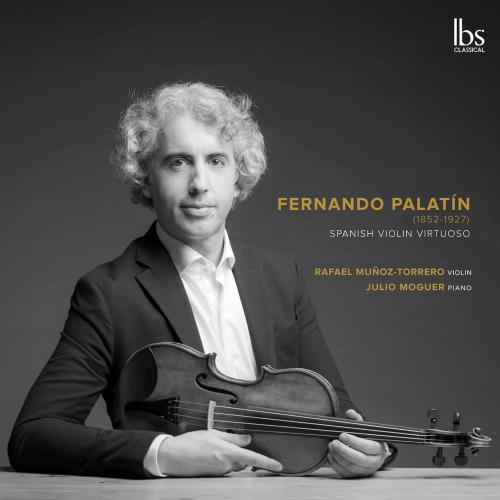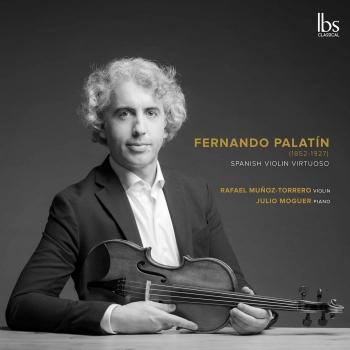
Palatín: Violin Works Rafael Muñoz-Torrero, Julio Moguer
Album Info
Album Veröffentlichung:
2021
HRA-Veröffentlichung:
11.03.2022
Label: IBS Classical
Genre: Classical
Subgenre: Instrumental
Interpret: Rafael Muñoz-Torrero, Julio Moguer
Komponist: Fernando Palatin (1852-1927)
Das Album enthält Albumcover Booklet (PDF)
- Fernando Palatín (1852 - 1927):
- 1 Palatín: Adiós al Alcázar 06:45
- 2 Palatín: Fantasía española 10:02
- 3 Palatín: Elegie for Violin & Piano 05:01
- 4 Palatín: Impromptu for Violin & Piano 02:08
- 5 Palatín: Mazurka sentimentale 03:39
- 6 Palatín: Fantasía de Carmen 11:36
- 7 Palatín: Cuento triste 03:58
- 8 Palatín: Andaluza 04:21
- 9 Palatín: Floresta 04:16
- 10 Palatín: Les guêpes 03:11
- 11 Palatín: Meditación 03:42
- 12 Palatín: Bluette 04:15
- 13 Palatín: Cuento alegre 02:01
- 14 Palatín: La Maja coqueta 02:45
Info zu Palatín: Violin Works
Palatín belonged to a musical line that dates back to the 18th century and among whose members we find, for example, the creator of the first Spanish musical dictionary. He was born in 1852 in Seville (Spain). From a young age he showed great musical talent and mastery of the violin, so it was considered when he was only 12 years old, that he should continue his studies in what was then the best place to study violin, The Imperial Conservatory of Paris. There, he would study with Jose White and with Jean-Delphin Alard, Pablo Sarasate´s teacher. This would be possible thanks to a scholarship granted by the Excelentísima Diputación de Seville after having won the relevant competition. His compositions include 29 pieces for violin and piano, a concerto for violin and orchestra which is only the second Spanish Romantic concerto for violin as well as works for orchestra, choir, chamber music or solo piano adding up to a total of 89 works.
Palatín’s compositional style, despite its own character was influenced by other works and composers and therefore we find a certain eclecticism in his work. What is a constant in the Romantic style is his use of free form that allows expression to be unleashed without being subject to the musical form.
Andaluza (1917). With an Andalusian dance character, this piece shows Palatín´s taste for folkloric-inspired music. Floresta (1915). This lyrical work evokes extra-musical poetic elements in the style of Robert Schumann. Carmen´s Fantasy (1882). This fantasy includes themes of the famous Bizet opera like the famous habanera. Elegía (1876). Dedicated to the widowed Duchess of Medinaceli. Avispas (Wasps), (1878/9). Probably inspired by Francoise Schubert’s bee. Mazurka sentimental (1916). A piece of central European inspiration and great lyricism. Impromptu (Babiole), (1880). Bagatelle with a jocular and cheerful character. Fantasía Española (1880). This piece links and develops in an elegant and virtuous way popular Spanish themes among which we can find El Vito or an Aragonese Jota, echoing popular songs. Meditación. A piece with a calm and evocative character where the violin sings with total prominence. Cuento alegre, 1916 y Cuento triste, 1921. These two pieces are of Central European flavor and to which Palatín tries to give a certain literary entity. Bluette. Gavotta that allows Palatín to express his compositional grace and elegance. La Maja coqueta (1917). This piece has a traditional and zarzuelan-like spirit where the violin shines with elegance.
There is no doubt that these pieces for violin are written with the intention to display the instrument either for its lyricism or to show its acrobatic possibilities. But this does not affect the musical beauty of his compositions because when he makes the violin sing he writes melodies of precious and original workmanship. In the same manner, the virtuosic pieces are not exempt from artistic interest.
Rafael Muñoz-Torrero, violin
Julio Moguer, piano
Keine Biografie vorhanden.
Booklet für Palatín: Violin Works










